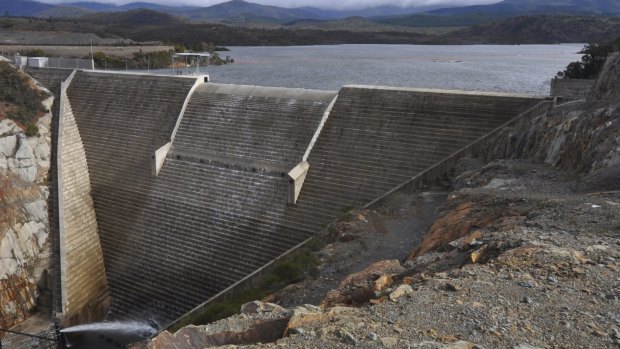- National
- ACT
This was published 7 years ago
ICRC looks to hand ACT's monopoly provider Icon Water the power to set prices
By Daniel Burdon
ACT residents will be spared the immediate effects of a $500 increase to annual water supply charges, as the independent market regulator looks to hand its price-setting role to Icon Water.
A draft decision from the Independent Competition and Regulatory Commission's 2016 tariff review shows the commission prefers one of two options to incrementally raise water supply charges as the per kilolitre price falls to the "marginal cost" over the decade from 2018.

Cotter Dam might be close to full, but ACT residents may yet face rising water bills.
But in a separate issue explored in the report, the commission has voiced its support for handing much of its price-setting role over the water market to the ACT's monopoly provider, Icon Water.
On the tariff review, the commission's draft report shows it backs "option A", increasing the annual water supply charge from the current $101 to $610; instead of "option B", which would only raise it to $390 over the same period.
Both options will see water users with low consumption levels paying more while larger waters users pay less, with changes to be implemented over a 10-year period to lessen the initial financial impact.
ICRC Commissioner Joe Dimasi said the proposal would raise the same overall amount of revenue for Icon Water, but it would change the tariff structure to "give the right signals" to consumers.
"What we're saying is we're giving a general direction, we're trying to make it a bit more flexible and we'd prefer a slow and steady change, taking a longer time period (to implement it) means if the conditions change you can take a long term approach to any adjustments," he said.
The draft report shows ACT water consumption had barely changed since water restrictions were lifted in 2010, while the ACT's dams were currently at 90 per cent capacity or higher.
Mr Dimasi said the commission did not have a position on whether consumers should use more water, but it did not make sense to have water overflowing the dams and not being used.
He also said the current pricing system was not effective and the new "marginal cost" structure would ensure the costs of running the system were still recovered, but in a more efficient way.
The new system, he said, would also be more flexible should a future drought occur.
While the commission currently sets the prices Icon Water charges, Icon had proposed in a previous submission to the tariff review that it could take over the commission's price-setting function, with the commission to review Icon's price proposals to ensure they were consistent with key "pricing principles".
An Icon spokeswoman said "if Icon Water sets prices, it would be doing so within constraints" set by the commission and "with no change in overall revenue".
Mr Dimasi said the commission supported "a move in this general direction".
"What we're saying is Icon is the business dealing with the customers, so they are in the best position to go out and consult with the community and come back to us with a set of prices," he said.
The system could be similar to the much-criticised Australian Energy Regulator's system, which some commentators have blamed for contributing to over-investment in the power distribution network.
But Mr Dimasi said while it was "pretty much the same", it did not matter which system was in place as "if we as regulators are not scrupulous and rigorous, that risk is there regardless".
The Icon Water spokeswoman said the "main difference" would be that "Icon Water would propose a tariff structure to the ICRC for their approval".
"The ICRC would still make the final decision on prices," she said.